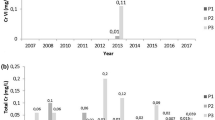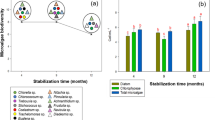Abstract
The bacterial reduction of Cr(VI) from industrial wastewater was evaluated using a 2.0-m3 bioreactor. Liquid pineapple waste was used as a nutrient for the biofilm community formed inside the bioreactor. The use of rubber wood sawdust as packing material was able to immobilize more than 106 CFU mL−1 of Acinetobacter haemolyticus cells after 3 days of contact time. Complete reduction of 15–240 mg L−1 of Cr(VI) was achieved even after 3 months of bioreactor operation. Cr(VI) was not detected in the final effluent fraction indicating complete removal of Cr from solution from the flocculation/coagulation step and the unlikely re-oxidation of Cr(III) into Cr(VI). Impatiens balsamina L. and Gomphrena globosa L. showed better growth in the presence of soil–sludge mixture compared to Coleus scutellarioides (L.) Benth. Significant amounts of Cr accumulated at different sections of the plants indicate its potential application in Cr phytoremediation effort. The bacterial-based system was also determined not to be detrimental to human health based on the low levels of Cr detected in the hair and nail samples of the plant operators. Thus, it can be said that bacterial-based Cr(VI) treatment system is a feasible alternative to the conventional system especially for lower Cr(VI) concentrations, where sludge generated can be used as growth supplement for ornamental plant as well as not detrimental to the health of the workers.



Similar content being viewed by others
References
Cushnie, G. C., Jr. (1985). Electroplating wastewater pollution control technology. Park Ridge, NJ: Noyes.
Shakoori, A. R., Makhdoom, M., & Haq, R. U. (2000). Applied Microbiology and Biotechnology, 53, 348–351.
Megharaj, M., Avudaiyanagam, S., & Naidu, R. (2003). Current Microbiology, 47, 51–54.
Garg, V. K., & Gupta, R. (2009). Vermicomposting of agro-industrial processing waste biotechnology for agro-industrial residues utilisation. In P. Singh nee’ Nigam & A. Pandey (Eds.), Biotechnology for agro-industrial residues utilisation. New York: Springer.
Zhou, S. Q., Lu, W. D., & Zhou, X. (2010). Effects of heavy metals on planting watercress in kailyard soil amended by adding compost of sewage sludge. Process Safety and Environment Protection, 88, 263–268.
Liu, J. N., Zhou, Q. X., Wang, X. F., Zhang, Q. R., & Sun, T. (2006). Potential of ornamental plant resources applied to contaminated soil remediation. In J. A. Teixeira da Silva (Ed.), Floriculture, ornamental and plant biotechnology: advances and topical issues (pp. 245–252). London: Global Science Books.
Hernández-Apaolaza, L., Gascó, A. M., Gascó, J. M., & Guerrero, F. (2005). Reuse of waste materials as growing media for ornamental plants. Bioresource Technology, 96, 125–131.
Gupta, U. C., Kening, W. U., & Liang, S. (2008). Micronutrients in soils, crops, and livestock. Earth Sciences Frontiers, 15, 110–125.
Ahmad, W. A., Zakaria, Z. A., Khasim, A. R., Alias, M. A., & Ismail, S. M. H. S. (2010). Pilot scale removal of chromium from industrial wastewater using the ChromeBacTM system. Bioresource Technology, 101, 4371–4378.
Aidid, S. B., & Okamoto, H. (1993). Responses of elongation growth rate, turgor pressure and cell wall extensibility of stem cells of Impatiens balsamina to lead, cadmium and zinc. BioMetals, 6, 245–249.
Jones, J. B., Jr. (2001). Laboratory guide for conducting soil tests and plant analysis (pp. 191–205). Boca Raton: CRC.
Radojevic, M., & Bashkin, V. N. (1999). Practical environment analysis (pp. 293–294). Cambridge: The Royal Society of Chemistry.
Andaleeb, F., Zia, M. A., Ashraf, M., & Khalid, Z. M. (2008). Effect of chromium on growth attributes in sunflower (Helianthus annuus L.). Environmental Sciences, 20, 1475–1480.
Lahouti, M., & Peterson, P. J. (1979). Chromium accumulation and distribution in crop plants. Journal of the Science of Food and Agriculture, 30, 136–142.
Parr, P. D., & Taylor, F. G., Jr. (1980). Incorporation of chromium in vegetation through root uptake and foliar absorption pathways. Environmental and Experimental Botany, 20, 157–160.
Zayed, A., Lytle, C. M., Qian, J. H., & Terry, N. (1998). Chromium accumulation, translocation and chemical speciation in vegetable crops. Planta, 206, 293–299.
Malandrino, M., Abollino, O., Buoso, S., Giacomino, A., Gioia, C. L., & Mentasti, E. (2011). Accumulation of heavy metals from contaminated soil to plants and evaluation of soil remediation by vermiculite. Chemosphere, 82, 169–178.
Keskinkan, O., Goksu, M. Z. L., Yuceer, A., Basibuyuk, M., & Forster, C. F. (2003). Heavy metal adsorption characteristics of a submerged aquatic plant (Myriophyllum spicatum). Process Biochemistry, 39, 179–183.
Gardea-Torresdey, J. L., Rosa, G. D. L., Peralta-Videa, J. R., Montes, M., Cruz-Jimenez, G., & Cano-Aguilera, I. (2005). Differential uptake and transport of trivalent and hexavalent chromium by tumbleweed (Salsola kali). Environment Contamination and Toxicology, 48, 225–232.
Marschner, H. (1995). Mineral nutrition of higher plants (2nd ed.). New York: Academic.
Cervantes, C., Garcia, J. C., Devars, S., Corona, F. G., Tavera, H. L., & Carlos, T. J. (2001). Interactions of chromium with micro-organisms and plants. Microbiological Reviews, 25, 335–347.
Liu, D., Zou, J., Wang, M., & Jiang, W. (2008). Hexavalent chromium uptake and its effect on mineral uptake, antioxidant defense system and photosynthesis in Amaranthus viridis L. Bioresource Technology, 99, 2628–2636.
Shanker, A. K., Cervantes, C., Loza-Tavera, H., & Avudainayagam, S. (2005). Chromium toxicity in plants. Environment International, 31, 739–753.
Acknowledgments
The authors acknowledged the support from the Ministry of Higher Education (MOHE), Malaysia for the FRGS grant (vote 78532) and Universiti Teknologi Malaysia for the GUP grants (Q.J13000.7125.00H26 and Q.J13000.7125.00H52) as well as the Ministry of Science, Innovation and Technology (MOSTI), Malaysia for the National Science Fellowship scholarship to Norsuhada Abdul Karim and Universiti Pendidikan Sultan Idris for the SLAB scheme to Wan Haslinda Wan Ahmad.
Author information
Authors and Affiliations
Corresponding author
Rights and permissions
About this article
Cite this article
Zakaria, Z.A., Ahmad, W.A., Zakaria, Z. et al. Bacterial Reduction of Cr(VI) at Technical Scale—The Malaysian Experience. Appl Biochem Biotechnol 167, 1641–1652 (2012). https://doi.org/10.1007/s12010-012-9608-9
Received:
Accepted:
Published:
Issue Date:
DOI: https://doi.org/10.1007/s12010-012-9608-9




